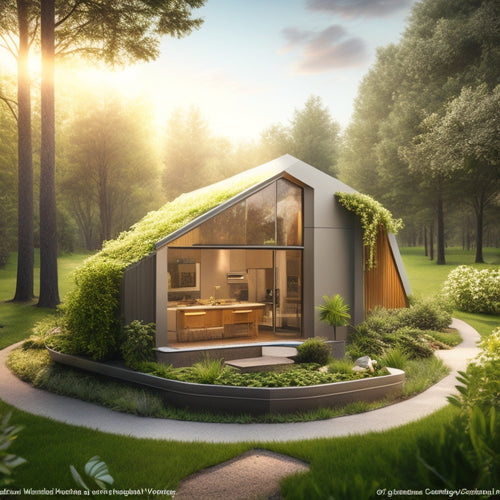
7 Home Geothermal Systems for Energy-Efficient Living
Share
You're considering upgrading to an energy-efficient home, and geothermal systems are top on your list, offering a potential 400% or more in energy efficiency ratings compared to traditional HVAC systems. Seven home geothermal systems stand out for energy-efficient living: Ground Source Heat Pumps, Hybrid Geothermal Systems, Closed-Loop Systems Design, Open-Loop Geothermal Systems, Direct Exchange Systems, Horizontal Loop Systems, and Pond Loop Geothermal Systems. Each system has its unique benefits, installation requirements, and maintenance needs. Exploring these options further will help you determine which one aligns best with your energy goals and property requirements, and gets you closer to a more sustainable living space.
Key Takeaways
- Ground source heat pumps achieve energy efficiency ratings of 400% or more, providing eco-friendly energy solutions for homes.
- Hybrid geothermal systems combine various heat sources and sinks for optimized performance, supporting cleaner energy solutions.
- Closed-loop systems, including horizontal, vertical, and pond/lake configurations, offer customizable solutions for specific heating and cooling needs.
- Direct exchange systems require careful design and installation to optimize heat transfer efficiency and minimize environmental impact.
- Energy storage integration and thermal batteries enable control over energy costs, reduce grid reliance, and contribute to a reduced carbon footprint.
Ground Source Heat Pumps
Most homeowners considering home geothermal systems are drawn to ground source heat pumps, a technology that employs the earth's natural heat to provide efficient and eco-friendly heating and cooling.
You'll appreciate the geothermal benefits, including reduced energy bills and a lower environmental impact. However, be prepared for installation challenges, such as drilling wells or excavating trenches.
As the shift to renewables enhances energy security and resilience Renewable Energy Sources, ground source heat pumps offer exceptional energy efficiency, with some systems reaching efficiencies of 400% or more.
With proper maintenance, system performance remains consistent, and advancements in technology continue to improve efficiency.
Residential applications are on the rise, with government incentives available to encourage adoption.
As you consider a ground source heat pump, remember its impressive climate adaptability, making it an attractive choice for homeowners seeking freedom from energy dependence.
Hybrid Geothermal Systems
You'll find that hybrid geothermal systems offer flexible design options, allowing you to combine different heat sources and sinks to optimize performance and efficiency.
By leveraging renewable energy solutions and integrating energy storage systems, such as thermal tanks, can further enhance hybrid system operation by shifting peak loads and reducing energy waste.
This approach can contribute to a cleaner, more sustainable transportation sector.
System Design Options
As you investigate the possibilities of home geothermal systems, you may find that a single technology can't fully meet your heating and cooling needs. This is where hybrid geothermal systems come into play, offering a solution to optimize system efficiency.
By combining different technologies, such as heat pumps and radiant floor heating, you can create a customized system that addresses specific climate and load requirements. Additionally, incorporating fast charging infrastructure can further enhance the system's overall energy efficiency, while also supporting the increasing adoption of electric vehicles.
Furthermore, the integration of energy storage systems can provide control over energy costs and reduce reliance on traditional power sources. However, this approach also presents installation challenges, as it requires careful planning and integration of multiple components.
When designing a hybrid system, it's vital to take into account factors like system sizing, piping layouts, and control strategies to guarantee seamless operation and maximum energy efficiency.
Energy Storage Integration
Integrating energy storage into your hybrid geothermal system allows you to take control of your energy costs and reduce your reliance on traditional power sources.
By incorporating a thermal battery, you can optimize efficiency and guarantee a consistent supply of renewable energy. This enables you to manage your energy usage effectively, shifting loads to periods of low demand and reducing your grid interaction.
Moreover, adopting a hybrid approach optimizes energy usage, controlling consumption and minimizing costs and environmental impact.
With a hybrid system, you can adapt to changing climate conditions and scale your system according to your needs.
Performance monitoring and real-time data analysis help you track your environmental impact and make data-driven decisions.
Cost Savings Analysis
Your hybrid geothermal system's thermal battery stores excess energy generated during off-peak hours, allowing you to offset peak demand charges and reduce your reliance on the grid.
This energy storage integration results in significant cost savings. While there's an initial investment, long-term savings come from reduced energy consumption and lower utility bills.
You may also be eligible for utility rebates and tax incentives, which can help offset the upfront cost. Additionally, financing options, such as low-interest loans and manufacturer financing deals, are available to make the system more accessible, much like electric vehicle adoption.
By leveraging these financing options, homeowners can overcome the initial cost hurdle and enjoy the long-term benefits of hybrid geothermal systems.
With lower maintenance costs and a reduced environmental impact, hybrid geothermal systems offer an attractive energy comparison.
Closed-Loop Systems Design
Three common configurations are used in closed-loop systems design: horizontal, vertical, and pond/lake systems. You'll need to take into account your property's size, soil type, and available space when selecting a configuration. The loop depth and soil conductivity will also impact the system's performance.
| Configuration | Description |
|---|---|
| Horizontal | Pipes are buried in trenches, 4-6 feet deep, in a horizontal configuration. Suitable for larger properties. |
| Vertical | Pipes are installed vertically in boreholes, 100-400 feet deep. Ideal for smaller properties with limited space. |
| Pond/Lake | Pipes are submerged in a body of water, providing a consistent temperature. Requires a nearby body of water. |
Open-Loop Geothermal Systems
In a water-source heat pump system, open-loop geothermal systems tap into a nearby aquifer or surface water body to employ the earth's natural heat.
As you contemplate this option, you'll want to weigh the open loop benefits, such as higher efficiency factors and lower installation requirements.
However, you'll also need to address the open loop challenges, including potential environmental impact and groundwater usage regulations.
Proper system maintenance is vital to guarantee the system runs efficiently and minimizes its ecological footprint.
You'll need to examine local regulations and permits when tapping into a water source.
Direct Exchange Systems
When designing a direct exchange system, you'll need to take into account the system's overall design, including the ground loop configuration, to guarantee efficient heat transfer.
You'll also need to control refrigerant flow to optimize system performance and minimize energy consumption.
System Design Considerations
Your home's geology and climate play an essential role in determining the feasibility of a direct exchange (DX) geothermal system. As you consider installing a DX system, you'll need to assess various factors that impact its performance and efficiency.
| Design Consideration | Impact on System | Importance |
|---|---|---|
| Site Assessment | System efficiency, thermal performance | High |
| Installation Challenges | System scalability, maintenance requirements | Medium |
| Regulatory Considerations | Environmental impact, system feasibility | High |
| Energy Audits | System efficiency, performance monitoring | Medium |
| Maintenance Requirements | System longevity, thermal performance | High |
Ground Loop Configuration
The ground loop configuration is a critical component of a direct exchange (DX) geothermal system, as it directly affects the system's thermal performance and efficiency.
When designing your DX system, you'll need to take into account the ground loop configuration that best suits your property.
-
Vertical loop configurations are ideal for smaller plots of land, where space is limited.
-
You'll need to decide on the geothermal drilling techniques to use, such as rotary drilling or percussive drilling.
-
The type of piping material and its thermal conductivity will also impact system performance.
- Finally, you'll need to verify the ground loop is properly sized to meet your heating and cooling demands.
Refrigerant Flow Control
With the ground loop configuration in place, you're now ready to focus on the refrigerant flow control system, a vital component of direct exchange (DX) geothermal systems.
This system guarantees refrigerant efficiency by managing the flow rate of refrigerant through the ground loop. Proper flow management is essential to achieve peak system performance, as it directly affects the heat transfer rate and overall system efficiency.
You'll need to select a refrigerant flow control method that suits your system's specific requirements, such as a thermostatic expansion valve or a variable speed compressor.
Horizontal Loop Systems
Across sprawling properties, horizontal loop systems prove to be a popular choice for homeowners.
You'll find that these systems offer several benefits, including:
- High efficiency ratings and seasonal performance that can greatly reduce your energy bills.
- Design flexibility that allows for easy installation around existing landscaping and infrastructure.
- Low maintenance requirements that minimize the need for frequent upkeep.
- Minimal environmental impact and land usage that preserves the natural beauty of your property.
However, you should also consider the installation challenges, such as soil types that may affect the system's performance.
With proper planning and execution, horizontal loop systems can provide you with a reliable and sustainable source of energy for years to come.
Pond Loop Geothermal Systems
You're evaluating another geothermal system option for your property. Pond Loop Geothermal Systems might be the way to go if you have a large body of water nearby.
This system involves submerging a loop of piping in a pond or lake to exchange heat with the water. The pipe is usually made of durable, corrosion-resistant material to minimize maintenance.
Pond maintenance is vital to guarantee the system's efficiency, so you'll need to take into account regular cleaning and water quality checks.
The benefits are worth it, though - Pond Loop Systems can be up to 30% more energy efficient than traditional HVAC systems.
With lower operating costs and a reduced carbon footprint, you'll be enjoying the freedom of energy-efficient living in no time.
Frequently Asked Questions
Can I Install a Geothermal System in an Existing Home?
You can install a geothermal system in your existing home, but consider the benefits, like reduced energy bills and carbon footprint, against installation considerations, such as space and pipe layout, to guarantee a seamless shift.
How Long Does It Take to Recoup the Cost of a Geothermal System?
You're probably wondering when you'll break even on your geothermal investment. The good news is that cost savings start adding up quickly, typically resulting in a payback period of 5-10 years, depending on factors like system size and local incentives.
Are Geothermal Systems Noisy or Disruptive to Daily Life?
You'll be pleased to know that modern geothermal systems are designed to minimize noise levels and system vibrations, ensuring a peaceful living environment with barely perceptible operational sounds, allowing you to enjoy your freedom from noise pollution.
Can Geothermal Systems Heat My Pool or Hot Tub?
You're wondering if geothermal energy can heat your pool or hot tub? Yes, it can! Geothermal systems can efficiently provide pool heating and hot tub efficiency, offering a cost-effective and eco-friendly solution for your relaxation needs.
Do Geothermal Systems Require Frequent Maintenance or Repairs?
You'll find that geothermal systems are built to last, with system longevity averaging 20-30 years; by following a regular maintenance schedule, you'll minimize repairs, ensuring your system runs efficiently and freely, without interruptions.
Related Posts
-

Why Biodegradable Dish Soap Matters for Earth-Conscious Homes
You likely don't realize that the dish soap you're using today will still be harming the environment long after you'v...
-

Transform Your Outdoor Space With Recycled Plastic Lumber
By incorporating recycled plastic lumber into your outdoor design, you're not just building a deck or installing a fe...
-

10 Best Sustainable Waste Management Solutions for Green Homes
You're likely unaware that the average green home generates over 2 kilograms of waste daily, but with the right susta...


